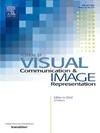Developing lightweight object detection models for USV with enhanced maritime surface visible imaging
IF 3.1
4区 计算机科学
Q2 COMPUTER SCIENCE, INFORMATION SYSTEMS
Journal of Visual Communication and Image Representation
Pub Date : 2025-05-22
DOI:10.1016/j.jvcir.2025.104477
引用次数: 0
Abstract
Maritime surface object detection is a key technology for the autonomous navigation of unmanned surface vehicles (USVs). However, Maritime surface object detectors often face challenges such as large parameter sizes, object size variations, and image degradation caused by complex sea environments, severely affecting the deployment and detection accuracy on USVs. To address these challenges, this paper proposes the LightV7-enhancer object detection framework. This framework is based on the CPA-Enhancer image enhancement module and an improved YOLOv7 detection module for joint optimal learning. First, a new lightweight backbone network, GhostOECANet, was designed based on Ghost modules and improved coordinate attention. Second, by integrating ELAN and Efficient Multi-scale attention, an ELAN-EMA module is constructed to enhance the network’s perception and multi-scale feature extraction capabilities. Additionally, to improve the detection accuracy of small objects, multi-scale object detection layers are added based on the YOLOv5 detection head. The paper also introduces CPA-Enhancer in conjunction with the improved YOLOv7 detection module for joint training to adaptively restore degraded Maritime surface images, thereby improving detection accuracy in complex maritime backgrounds. Finally, the SeaShips dataset and Singapore Maritime Dataset are used to evaluate and compare LightV7-enhancer with other mainstream detectors. The results show that LightV7-enhancer supports object detection in various degraded maritime scenarios, achieving a balance between accuracy and computational complexity compared to other mainstream models. Compared to the baseline YOLOv7, LightV7-enhancer improves mAP by 2.7% and 7.5% on the two datasets, respectively, and has only half the number of parameters of YOLOv7, demonstrating robustness in degraded sea surface scenarios.
开发具有增强海洋表面可见成像的USV轻型目标检测模型
海面目标检测是实现无人水面航行器自主导航的关键技术。然而,海面目标探测器往往面临着参数尺寸大、目标尺寸变化、复杂海洋环境导致的图像退化等挑战,严重影响了无人水面艇的部署和探测精度。为了解决这些挑战,本文提出了LightV7-enhancer目标检测框架。该框架基于CPA-Enhancer图像增强模块和改进的YOLOv7检测模块进行联合最优学习。首先,基于Ghost模块和改进的坐标关注,设计了一种新的轻量级骨干网GhostOECANet。其次,通过整合ELAN和高效多尺度注意力,构建ELAN- ema模块,增强网络感知和多尺度特征提取能力;此外,为了提高小目标的检测精度,在YOLOv5检测头的基础上增加了多尺度目标检测层。本文还引入CPA-Enhancer,结合改进的YOLOv7检测模块进行联合训练,自适应恢复退化的海面图像,从而提高复杂海洋背景下的检测精度。最后,使用SeaShips数据集和新加坡海事数据集对lightv7增强器与其他主流探测器进行评估和比较。结果表明,与其他主流模型相比,lightv7增强器支持各种退化海洋场景下的目标检测,实现了精度和计算复杂性之间的平衡。与基线YOLOv7相比,LightV7-enhancer在两个数据集上的mAP分别提高了2.7%和7.5%,且参数数量仅为YOLOv7的一半,显示出在退化海面情景下的鲁棒性。
本文章由计算机程序翻译,如有差异,请以英文原文为准。
求助全文
约1分钟内获得全文
求助全文
来源期刊

Journal of Visual Communication and Image Representation
工程技术-计算机:软件工程
CiteScore
5.40
自引率
11.50%
发文量
188
审稿时长
9.9 months
期刊介绍:
The Journal of Visual Communication and Image Representation publishes papers on state-of-the-art visual communication and image representation, with emphasis on novel technologies and theoretical work in this multidisciplinary area of pure and applied research. The field of visual communication and image representation is considered in its broadest sense and covers both digital and analog aspects as well as processing and communication in biological visual systems.
 求助内容:
求助内容: 应助结果提醒方式:
应助结果提醒方式:


